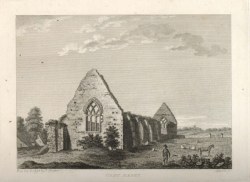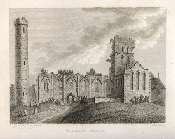May 04, 2005
GROSE'S ANTIQUITIES 1792 GREY ABBEY KILDARE

GRAY ABBEY.
THIS plate exhibits the north-west view of the abbey. The roof at this end is totally decayed, but the walls and eastern windows remain nearly entire. On a gravestone in the church-yard is the following epitaph:
Here lies Jean Hay,
Who night and day
Was honest, good, and just;
Her hope and love
Was from above,
In which place was her trust.
Her spirit left her terrene part,
With joy to God, where was her heart.
On the 4th day of January, 1706 / 7.
THIS View was drawn by Lieutenant Daniel Grose, anno 1792.
(p. 83, Vol. II)
Grey Abbey Kildare - history of Grey Abbey is mistakenly included under Kildare Abbey (pp. 25-26, Vol. I).
The original entry for Kildare Cathedral is recorded as follows...
Groses's Antiquities of Ireland: - County Kildare in the 1790's
KILDARE ABBEY, KILDARE.
(It seems to confuse Grey Abbey with Kildare Cathedral. The accompanying image and description is of the Cathedral but the early part of the history refers to Grey Abbey at Kildare - Mario Corrigan)
THIS town, situated about 28 miles from Dublin, was early celebrated for the virtue and miracles of St. Bridget, and for an inextinguishable fire preserved by her nuns. The latter succeeded the Druidesses, among whom fire was a sacred element, and kept with singular care.
THIS, called the Gray Abbey, is on the south side of the town, and was erected for friars of the Franciscan order in the year 1260, by Lord William de Vescy, but the building was completed by Gerald Fitz Maurice, Lord Offaley. He died in 1286, at Rathmore, near Naas, and was interred here.
JOHN Fitz Thomas, the first Earl of Kildare, dying at Larraghbrine near Maynooth, was buried in this church A. D. 1316. This nobleman had great variance with William de Vescy, Lord of Kildare and Lord Justice. They appealed to the king, and the Lord Justice was challenged, but declined the combat, and fled into France, whereupon the king pronounced John Fitz Thomas innocent, and bestowed on him the title of Earl of Kildare, which the other enjoyed. Three other earls of this noble house are entombed in this friary.
THE 34th Henry VIII. this monastery with its appurtenances, two gardens, and two closes of land with four messuages, &c. together with the house of the White Friars, were granted in capite to Daniel Sutton, at the annual rent of 2S. 3d. Irish money.
PART of the tower of this church still remains, and a portion of the walls, which show it to have been well constructed. The round tower adjoining it is a beautiful object. We see here six Gothic arches and as many buttresses. The north side of the steeple is leveled with the ground, said to have been beaten down by a battery planted against it in the rebellion 1641. The south wing is in ruins, it was formerly a chapel, and in it are two statues in alto relievo. One represents a bishop in his robes, a pastoral staff in his right hand, and a mitre on his head, supported by two monkeys. As there is no inscription, it is conjectured to belong to Edmund Lane, Bishop of Kildare, who was buried here A. D. 1522. The other is a monument of Sir Maurice Fitz Gerald of Lackugh, curiously cut in armour, with an inscription and five escutcheous differently emblazoned.
THE round tower is 132 feet high, adorned with a battlement, and not far from this is the fire-house. Henry de Loundres, Archbishop of Dublin in 1220, put out the fire, but it was re-lighted after, and continued to burn till the suppression of monasteries. One miracle attendant on this fire was, that notwithstanding its perpetual consumption of fuel, ashes never increased: nor was the fire ever to be blown by human breath for fear of contamination, but by vans or bellows.

This view, was taken from a drawing by Dr.Wynne.
(pp. 25-26, Vol. I)
Posted by mariocorrigan at 08:16 PM | Comments (0)